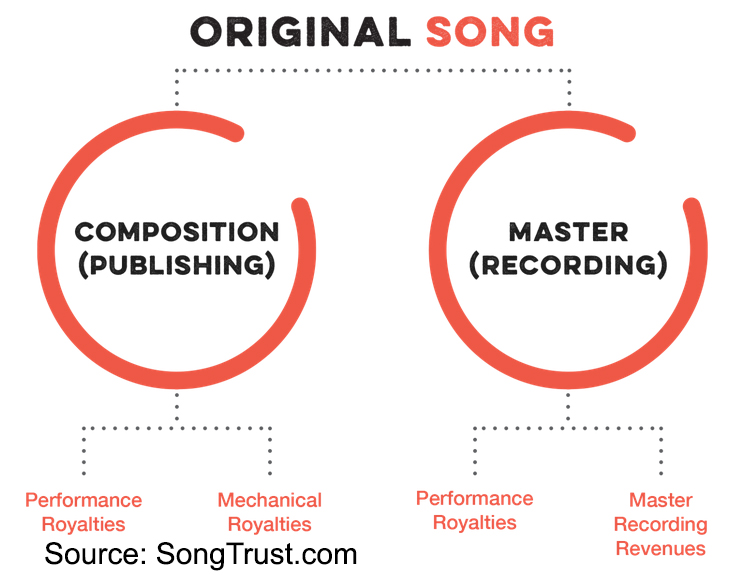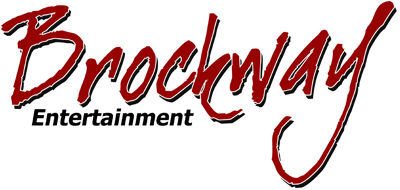Areas of Royalties
At the highest level, a song can be thought of as being split into two halves:
- the composition aka publishing (the underlying song—like lyrics and notes)
- the master sound recording
These above two halves also each have two halves, making 4 areas of royalties.
- Composition/Publishing + Performance royalties (SOCAN)
- Composition/Publishing + Mechanical royalties (CMRRA OR SOCAN-RR)
- Master Sound Recording + Performance royalties (ACTRA-RACS, ARTISTI OR Re:Sound,
MROC)
- Master Sound Recording revenues (distributor AND SOPROQ, CONNECT OR Re:Sound)

|
1. Composition/Publishing + Performance royalties
Performance rights (Composition): The right to publicly perform
In Canada, the organization is SOCAN.
Performance royalties are generated from public performances such as live performances, terrestrial (FM/AM) radio play, tv/film/advertising usage, Stores/Restaurants, gyms, and streams (both interactive and non-interactive).
Live streaming shows can now be submitted to SOCAN for performance royalties.
|
2. Composition/Publishing + Mechanical royalties
Mechanical royalties / Reproduction right (Composition): The right to reproduce the song composition.
Mechanical royalties are royalties paid to a songwriter, composer, or music publisher whenever a physical or digital copy of one of their songs or compositions is made.
Mechanicals:
- Compensation for the usage of a song. Streamed, played or downloaded.
- Platforms need a (mechanical) license to play someone’s song. (e.g. spotify, radio, etc)
- In the middle, there is a match using ISRC codes so that royalties are sent to correct people.
- They play the song and mechanical royalties come back.
Canada options: SOCAN-RR (songwriters & publishers) OR CMRRA (publishers). Both are good.
For indie artists, SOCAN-RR is likely the best option. It is more geared towards songwriters and your SOCAN catalogue is used for SOCAN-RR.
SOCAN RR pays royalties separately to writer and publisher members. CMRRA remits all reproduction rights royalties to the publisher who then pay authors per their contractual agreements.
SOCAN-RR & CMRRA both now have reciprocal agreements with similar international organizations. As well as other places like YouTube.
You’ll hear talk of Harry Fox Agency (HFA) in the US a lot, and both Canadian organizations collect from HFA.
SOCAN RR notes
- You can submit your tracks via an excel document containing 3 columns: Title, ISRC code, Performer.
- Featured artists do not need to be included.
- “Your ISRC codes are not in your catalog of works but information to facilitate the identification of your digital tracks and is automatically matched with the files that we receive from music providers.”
- Socan RR does not require the ISRC assigned to a music video. "If your songs are already registered with SOCAN RR you don't need to register the music videos. The music videos will contain the meta data of the songs. All royalties related to music videos will be matched up based on (a) artist + song title OR (b) via contentID for YouTube."
- Monetizing of YouTube/Facebook is necessary to get paid by SOCAN RR for any works on those platforms.
- This is disappointing, as I was hoping that embedding your ISRC code into the video would be sufficient.
|
3. Master Sound Recording + Performance royalties
Performance of the master recording (Neighbouring rights): The right to publicly perform or broadcast the sound recording
There are two sides to this:
- the main/featured artists
- the background musicians / artists. Colin: “musicians who perform on an album and are listed in the credits but not a featured artist”
The split is different between featured (main artist/band) and non-featured (session players) performers. In Canada, the split is 80/20, and in the U.S., it’s 90/10.
In Canada, collection occurs in more avenues than in the U.S. (U.S. radio broadcasters & public venues are not included).
Performance Rights Organizations (PRO):
- The following PROs all collect for Canadians: ACTRA RACS, ARTISTI & Re:Sound. Note: MROC is shutting down 31 Dec 2024 and transferring clients to ARTISTI.
- All collection groups have reciprocal agreements with agencies in other territories, so you do not need to sign up elsewhere.
- They also provide the option to carve out (opt out) of individual territories. (See SoundExchange below)
- Typically recommended to not join Re:Sound directly. Instead sign up with individual Canadian organizations like ACTRA RACS or ARTISTI
- ACTRA RACS (Actors Union) has typically been for english artists
& ARTISTI for French artists, however when MROC shut down they transitioned their clients to ARTISTI.
MROC Notes (provided by MROC):
- When there are 2 main artists on a track, "you can list the two artists in the Artist and/or Band field in any format you want. You should then include your legal names in the Featured Performer field to make sure we attach the correct performer"
- When a person has multiple performer names, "MROC has a function in our system where we can have your repertoire under different names if necessary."
Hip-Hop / Beatmakers:
- For a beatmaker, since the music/beats are in the background (e.g. background musicians), then they would be considered a background artist, which means they are a part of the 20% cut.
- If the beatmaker is listed as a main or featured artist (often the case for remixes), then they are part of the 80% cut.
- Or depending on the contract, the beatmaker might request to not be listed at all and receive 0%.
US Territory / SoundExchange:
On non-interactive digital platforms like SiriusXM, the U.S. pays sound recording performers through an entity called SoundExchange. E.g. Pandora, SiriusXM, iHeart Radio, webcasters, etc
The Canadian PROs have agreements to collect from SoundExchange. If you’re an artist with smaller income from US non-interactive streaming, then you can likely skip this section.
An artist should consider looking into signing up with SoundExchange if they have significant income from US non-interactive streaming (e.g. satellite radio).
If you sign up directly with SoundExchange, here are some things to consider:
- Benefits: (a) Save 4.5% admin fee charged by Canadian PROs; (b) paid in US $$ (no exchange fee); (c) paid more quickly; (d) and more detailed information about plays.
- Con: Dealing INSTEAD with a Canadian PRO may make tax accounting easier for Canadians. ( https://edwardslaw.ca/blog/soundexchange/ )
- Admin: With the Canadian PRO, set it so it does not collect for US territory.
- Admin: With SoundExchange, set it so it ONLY collects in the US.
Example: CBC Radio 3 / CBC Radio 1 streamed on Sirius XM in the united states.
- Featured artists collected via SoundExchange.
- Background artists collected via SAG-AFTRA, which flows to Canadian agency.
US Territory: SoundExchange (main/featured artists), SAG-AFTRA (background artists)
|
4. Master Sound Recording revenues
2024 UPDATE: Effective 1 Jan 2025, CONNECT will be terminating its mandates with indie members and encouraging them to sign with SOPROQ.
Reproduction of Master recording right: The right to reproduce the sound recording
Master recording revenues. Paid to whoever owns the master sound recording (typically record labels). Your distributor pays most of this.
Some payments come via Canadian organizations: CONNECT (English), Re:Sound OR SOPROQ (French)
Typically recommended to not join Re:Sound directly. Instead sign up with individual Canadian organizations like CONNECT. (Reconsider this given the 2025 CONNECT changes)
This article indicates the percentage that background Producers & Beatmakers receive is 3%-5% of the master royalties.
This is also a useful article about producer points (3%): How Do Producer Points Work in a Record Deal?
Notes (provided by CONNECT / Re:Sound):
- When ownership of a sound recording is split between 2 registrants (e.g. 50-50, 95-5), “you are only responsible for submitting your portion of the ownership and it is up to the other party to sign up and register their portion themselves.”
- When there are featured artists on your track, “track artist and track title need it to be exactly the same as what you used when you released it so it will match up to what the radio stations have”.
- “It is best to submit all the titles you own the master rights to (including physical-only and digital-only), in case they come up in the logs somewhere.”
Notes on music videos (provided by CONNECT / Re:Sound):
- When an audio track has an accompanying music video, these should be submitted “as 2 separate repertoire line items one for A (audio) and one for V (video)”.
A “music video should have its own separate ISRC code” that is different from the ISRC code for the audio recording.
- “You can register any music videos that you have released.” These can include live performance videos.
- CONNECT “doesn’t have anything to do with YouTube. Any (master sound recording) royalties from YouTube would be done directly with them” (or a monetization company).
CONNECT Submission form: https://connectmusic.ca/members/repertoire-submission.aspx
Help filling out the form: https://www.connectmusic.ca/media/1101/nrcc_cpcc_eligibility%5b1%5d.pdf
|
Re:Sound & Master Sound Recording
Re:Sound is an alternate option for signing up for both master sound recording royalties & revenues.
It does require 2 separate registrations for the 2 types of royalties even though it is 1 organization.
Re:Sound distributes the amounts collected in two equal royalty streams:
- Performance: The royalties for musicians and vocalists (performers) are disbursed to ACTRA RACS, Artisti, for distribution to their respective eligible performers. Or artists can sign up directly with Re:sound
- Reproduction: The royalties for record labels (makers) are disbursed to CONNECT www.connectmusic.ca and SOPROQ www.soproq.org for distribution to their respective eligible members.
|
Spotify high-level breakdown (2021)
33% goes to spotify (Source: Spotify)
67% paid to artists as follows:
- 6.5% - performance (composition/publishing). paid by SOCAN. (US 2021 rate) Source
- 5.3% - mechanicals (composition/publishing). paid by SOCAN-RR / CMRRA. (US 2021 rate) Source
- ~55% - Recording: master sound recording revenue: Paid by distributor (distrokid, tunecore, etc) to whoever is signed up with the distributor.
|
Feedback
Did you find this useful? Is something out of date or incorrect? Please let me know.
|

